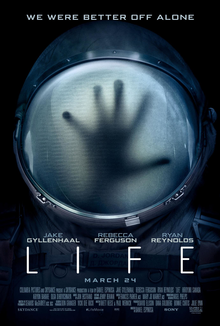| Life | |
|---|---|
 |
by Peter J. O'Connell
Life. Released: March 2017. Runtime: 103 mins. MPAA Rating: R for language throughout, some sci-fi violence and terror.
Life begins at the moment of capture. What is captured is a space probe containing a soil sample from Mars. The probe is captured by the six-person crew of an international space station (ISS). Director Daniel Espinosa's film shows the life-and-death struggles that follow from this seminal event.
The lab work of British biologist Hugh Derry (Ariyon Bakare) on the sample uncovers a dormant organism. Derry is able to get the organism to grow and react to stimuli. Because each cell in the organism is a myocyte, neuron, and photoreceptor—all at the same time—one of the scientists in the crew remarks that the organism is “all muscle, all brain and all eye.” All dangerous, too, as it soon turns out.
For a time, however, the organism is seen as a wonderful thing. Humankind is not alone in the universe! Developments on the ISS are broadcast to Earth, and schoolchildren name the organism “Calvin.” But an accident causes the organism to go dormant again.
Hugh decides to revive Calvin with a mild electric shock. Calvin does reanimate, but as a monstrously yucky growing, evolving creature—part octopus, part bat, part snake, part plant—a creature that seeks to crush humans and eat its way in and out of them.
While this slithy tove doth gyre and gimbel throughout the ISS, the crew members seek in various ways to combat it. American engineer Rory Adams (Ryan Reynolds) uses fire. Russian commander Katerina Golovkina (Olga Dihovichnaya) does a space walk in an attempt to restore communication with Earth, which has become disrupted. Japanese pilot Sho Kendo (Hiroyuki Sanada), whose wife in Japan has recently given birth to a baby, attempts to deprive the creature of oxygen, which it needs. Physicians David Jordan (Jake Gyllenhaal), an American, and Captain Miranda North (Rebecca Ferguson), a Brit connected with the Centers for Disease Control, try a number of strategies.
As effort after effort to defeat the creature fails, and one after another crew member perishes—horribly--the being from another world comes to seem almost like the deity of the early Calvinists, who held sinners in an angry hand to punish them.
As the various desperate stratagems go on, suspense intensifies. Will mission control learn enough about what is going on at the ISS to send modules to bring survivors, if there are any, back to Earth? If it does, will Calvin make its way into one of the modules and bring apocalypse to the planet whose inhabitants hoped to find out if they were not alone in the universe?
Life is a thrilling thing. The production design of the ISS is magnificent, and the special effects are terrific. The acting is skillful, particularly since much of it is seemingly done while floating in air. Yes, the plot situation is similar to that of Ridley Scott's classic Alien (1979), but in the sense of a genre convention rather than an overused cliché. So see this movie. It will “scare the life out of you”—which is always enjoyable.
“Footnote” to the film: Those who complain about the similarities of Life to Alien should ask themselves if Westerns of later decades should not have had shootouts between good guys and bad guys in bars or main streets because Westerns of earlier decades had that plot feature. Life has a monster stalk a spaceship crew, and so did Alien 38 years earlier. But after all, producer Howard Hawks and director Christian Nyby in The Thing From Another World (1951) had a monster stalk the crew of a space-related facility (though one on Earth) 38 years before Alien! And Hawks and Nyby were just transferring a horror story trope—the monster in a mansion—into a science-fiction context. In short, Life has a life of its own.
No comments:
Post a Comment